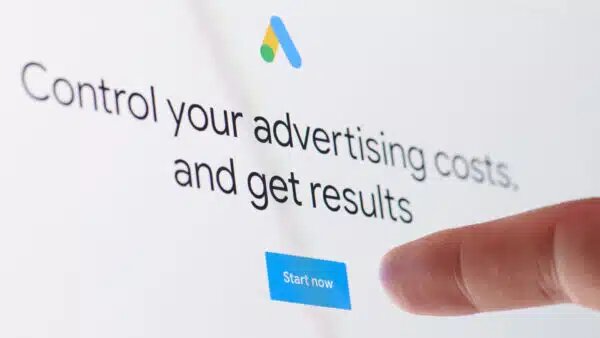Learn how Google’s out-of-order ad promotion in search auctions impacts ad positioning and advertisers’ strategies.
During the ongoing DOJ antitrust trial against Google, the company reiterated it sometimes shows lower-ranked ads ahead of top-ranked ads.
This practice is known as out-of-order ad promotion. This little nuance to how the ad auction works can be confusing, so in this article, I’ll explain how out-of-order promotion works and why Google does it.
How Google ranks ads in auctions
Google uses second-price ad auctions to determine which ads show for a search query and how much advertisers pay for clicks. Advertisers bid on keywords, and their ad position is based on Quality Score, which, in highly simplified terms, is a combination of bid amount and predicted click-through rate.
This combined score is known as Ad Rank. The ad with the highest Ad Rank wins the top slot on the page.
The following table shows an example of two ads with different predicted CTRs and maximum CPCs and how those factors combine to determine ad rank and position on the page:
 100vw, 1922px” data-lazy-src=”https://searchengineland.com/wp-content/seloads/2023/09/How-Google-ranks-ads-in-auctions.png.webp” /></figure>
</div>
<p>But there is more complexity than what the table indicates. Google maintains several thresholds or conditions an ad must meet before it can be shown in certain locations on the SERP, like the more desirable positions above organic search results.</p>
<p>Google’s ad thresholds include:</p>
<ul>
<li>A reserve auction price (typical in most auctions where the seller can require a minimum price).</li>
<li>A minimum relevance factor.</li>
<li>Adherence to editorial ad standards.</li>
</ul>
<p>The idea behind the relevance threshold is simply that the most relevant results should be at the top, and if ads are less relevant than organic results, there should be no ads before organic results.</p>
<p>So even if an ad wins the top auction rank, it may not be eligible to show in the number one slot because its ad rank is below the reserve, its expected click-through rate (CTR) is below the relevance threshold, or the ad is unreviewed and hence can’t be guaranteed to meet editorial standards.</p>
<p>For example, if Google wants ads at the top of the SERP to have at least a 4% predicted CTR, then Ad 1 in our example above would still have a higher rank than Ad 2, but it would not be allowed to be shown at the top of the SERP. It would still be eligible for an ad slot lower on the page with lower relevance threshold.</p>
<p>Where it gets messy is when the lower-ranked ad does meet all the criteria but is forced to stay behind the higher-ranked ad which fails some of the criteria.</p>
<p>In our example, Ad 2 meets the relevance requirement because its predicted CTR is 5%, higher than the 4% threshold.</p>
<p>But as its ad rank is lower than Ad 1, to maintain auction fidelity, it should also move further down the page and show up after wherever Ad 1 is allowed to show.</p>
<p>This is not a great scenario for advertisers or Google, so they address this by allowing ads to be shown in a different order than what ad rank would normally dictate.</p>
<h2 id=) Why Google allows out-of-order promotion
Why Google allows out-of-order promotion
To show relevant ads above search results, Google will sometimes promote the second-ranked ad ahead of the first-ranked ad. This allows a more relevant ad to take the premium real estate.
It benefits Google and users:
- Google can still show ads in high-visibility spots above organic results. This increases potential revenue.
- Users see more relevant ads in premium locations. This improves the search experience.
- Advertisers with high-relevance ads stuck behind a less relevant ad with a higher CPC can still show up in more premium locations where they are more likely to get clicks.
In the same example as before, if Google has a 4% threshold for relevance but allows out-of-order promotion, they can now show the ads in a different order. Ad 1 and Ad 2’s positions are reversed, and only Ad 2 shows above the organic results.
 100vw, 1926px” data-lazy-src=”https://searchengineland.com/wp-content/seloads/2023/09/Why-Google-allows-out-of-order-promotion.png.webp” /></figure>
</div>
<p>We know the above is true because we see different numbers of ads above the organic results for different searches. As we can see, Google has an algorithm that determines on the fly which ads can appear in various locations on the SERP.</p>
<p>Out-of-order promotion also allows Google to enforce its relevance standards. Without it, low-quality ads could occupy top spots just by bidding high – even if users are unlikely to find them useful.</p>
<hr class=)
How out-of-order promotion impacts advertisers
For the demoted, first-ranked ad, out-of-order promotion means losing the top slot and being pushed down the page. It may still pay a high CPC because its low Quality Score means it must spend more on the CPC to meet any ad rank thresholds.
For the promoted, second-ranked ad, it provides a chance to gain greater visibility than its rank alone would permit. The advertiser will pay no more than their max CPC but may pay more than if they had not been promoted ahead of Ad 1.
As Google says in its support materials:
“Your actual CPC is calculated based on your Ad Rank, including the thresholds and competition from other advertisers.”
This indicates that the price Ad 2 pays to jump over Ad 1 and stay at the top of the page may be higher than if it had been shown in the regular order, where it only had to pay the minimum to beat the next highest-ranked ad.
For advertisers further down the rankings, it can start a chain reaction of ads moving up a slot as the demoted ad falls.
In general, out-of-order promotion aims to balance relevance for users with revenue for Google. Advertisers may see fluctuations in ad position and cost per click as a result.
Navigating Google’s ad auctions
While out-of-order promotion changes the typical auction dynamics, Google believes it ultimately improves the search experience, and I tend to agree with that.
For advertisers, it highlights the need to focus both on bidding strategically and optimizing for relevance and Quality Score.



